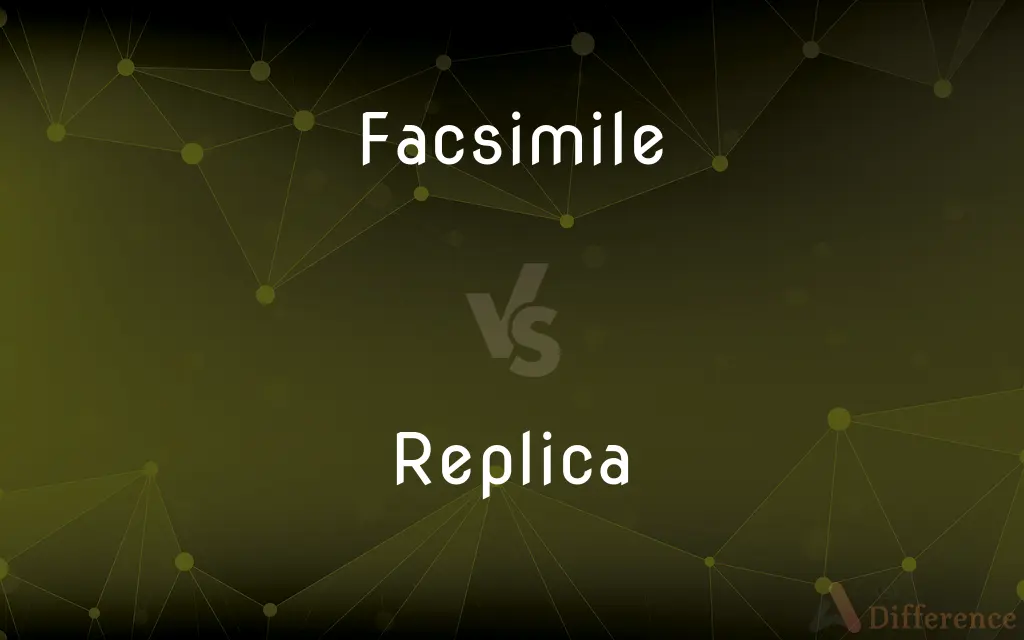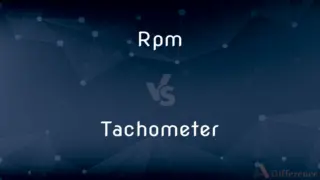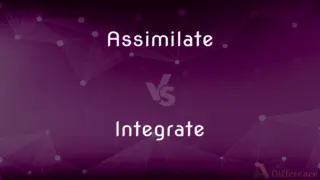Facsimile vs. Replica — What's the Difference?
By Tayyaba Rehman & Maham Liaqat — Updated on March 26, 2024
A facsimile is an exact copy or reproduction of a document, artwork, item, used for archival or preservation purposes, while a replica is a close but not always exact copy of an object, often recreated for display or use when the original is unavailable.

Difference Between Facsimile and Replica
Table of Contents
ADVERTISEMENT
Key Differences
Facsimiles are created to replicate the original as closely as possible, capturing not only the content but also the appearance, texture, and even imperfections of the original item. They are commonly used in the context of documents, manuscripts, and prints, where the visual and textual fidelity to the original is paramount. On the other hand, replicas may vary in the degree of accuracy and detail in relation to the original. They are often produced for a range of purposes, including museum displays, educational tools, or commercial items, where the essence and general appearance of the original are more important than an exact duplication.
While a facsimile focuses on exact duplication for purposes like study, preservation, or legal documentation, a replica serves to bring a representation of the original into contexts where having an exact copy is either unnecessary or impractical. This distinction highlights the different priorities in producing facsimiles and replicas: fidelity versus accessibility.
In producing a facsimile, the goal is to achieve as perfect a copy as possible, often using specialized techniques to capture the details of the original. Replicas, however, might be created using different materials or techniques, aiming for visual similarity rather than exact duplication, and can sometimes be of a different scale or size.
The significance of facsimiles lies in their ability to preserve historical, legal, and artistic integrity, allowing for the dissemination of valuable originals without exposing them to damage. Replicas, while they may not offer the same level of detail or authenticity, make the essence of rare or valuable objects accessible to the public, enhancing educational and cultural appreciation.
The choice between a facsimile and a replica depends on the purpose of the reproduction: whether the goal is to study the original in great detail or to appreciate its aesthetic and historical significance in a more general sense.
ADVERTISEMENT
Comparison Chart
Definition
An exact copy, focusing on duplicating the original's appearance and content
A close but not always exact copy, created for display or practical use
Purpose
Preservation, study, legal documentation
Education, display, commercial use
Fidelity
High, aims for exact duplication
Varies, aims for visual and essence similarity
Production
Specialized techniques to capture details
May use different materials or techniques
Significance
Preserves historical, legal, and artistic integrity
Makes the essence of objects accessible for appreciation
Compare with Definitions
Facsimile
A precise copy of a work of art.
The artist created a facsimile of the original painting for the archive.
Replica
A reproduction of an artwork for display.
The gallery sells replicas of famous paintings.
Facsimile
An exact reproduction of a document.
The museum displayed a facsimile of the ancient manuscript.
Replica
An educational tool mimicking an original.
Students used a replica of an archaeological artifact for study.
Facsimile
An exact copy for preservation purposes.
Facsimiles of the original letters were made to prevent further wear.
Replica
A commercial copy of a fashion item.
The store offers replicas of vintage jewelry.
Facsimile
A duplicate of an item, mirroring its state.
The library obtained a facsimile of the rare book for researchers.
Replica
A close copy of a historical artifact.
The museum's replica of the ancient statue is available for public viewing.
Facsimile
A reproduction capturing the original's texture and appearance.
A facsimile of the historic map was used for the exhibition.
Replica
A model replicating an original object.
He built a replica of the historic ship for the exhibition.
Facsimile
A facsimile (from Latin fac simile, "to make alike") is a copy or reproduction of an old book, manuscript, map, art print, or other item of historical value that is as true to the original source as possible. It differs from other forms of reproduction by attempting to replicate the source as accurately as possible in scale, color, condition, and other material qualities.
Replica
A replica is an exact copy, such as of a painting, as it was executed by the original artist or a copy or reproduction, especially one on a scale smaller than the original.A replica is a copying closely resembling the original concerning its shape and appearance. An inverted replica complements the original by filling its gaps.
Facsimile
An exact copy or reproduction, as of a document.
Replica
A copy or reproduction of a work of art, especially one made by the original artist.
Facsimile
See fax.
Replica
A copy or reproduction, especially one on a scale smaller than the original.
Facsimile
Of or used to produce exact reproductions, as of documents.
Replica
An exact copy.
The statue on the museum floor is an authentic replica.
Facsimile
Exactly reproduced; duplicate.
Replica
A copy made at a smaller scale than the original.
He collected replicas of old cars.
Facsimile
(countable) A copy or reproduction.
Replica
A copy of a work of art, as of a picture or statue, made by the maker of the original.
Facsimile
(uncountable) Reproduction in the exact form as the original.
Replica
Repetition.
Facsimile
A fax, a machine for making and sending copies of printed material and images via radio or telephone network.
Replica
Copy that is not the original; something that has been copied
Facsimile
The image sent by the machine itself.
Facsimile
(transitive) To send via a facsimile machine; to fax.
Facsimile
(transitive) To make a copy of; to reproduce.
Facsimile
A copy of anything made, either so as to be deceptive or so as to give every part and detail of the original; an exact copy or likeness.
Facsimile
To make a facsimile of.
Facsimile
An exact copy or reproduction
Facsimile
Duplicator that transmits the copy by wire or radio
Facsimile
Send something via a facsimile machine;
Can you fax me the report right away?
Common Curiosities
What is the main purpose of creating a facsimile?
The main purpose of creating a facsimile is to produce an exact copy of an original document, artwork, or item for preservation, study, or legal documentation.
Why might someone choose a replica over a facsimile?
Someone might choose a replica over a facsimile for practical reasons such as cost, availability, or the need for a durable item for display, education, or commercial use.
How accurate are replicas?
The accuracy of replicas can vary. While some replicas strive for high fidelity to the original, others may prioritize capturing the essence or aesthetic of the original rather than exact details.
Are replicas considered authentic?
Replicas are not considered authentic in the sense of being the original item, but they can be authentic representations of the original's appearance and essence.
Can facsimiles be used as legal documents?
Yes, facsimiles can be used as legal documents when an exact copy of the original is required for verification, archival, or documentation purposes.
Can a facsimile capture the texture of the original?
Yes, a facsimile can capture the texture of the original using specialized reproduction techniques, making it an exact copy not just in appearance but also in feel.
How do museums use replicas?
Museums use replicas to display representations of artifacts that are too fragile, valuable, or rare to be exhibited to the public, enabling educational and cultural appreciation.
What are the ethical considerations in creating replicas?
Ethical considerations in creating replicas include transparency about the replica's status, ensuring replicas do not devalue the original, and avoiding potential forgeries or misrepresentations.
What technologies are used to create facsimiles?
Technologies used to create facsimiles include high-resolution scanning, photographic reproduction techniques, and advanced printing methods that capture the detail and texture of the original.
What role do facsimiles play in preserving history?
Facsimiles play a crucial role in preserving history by allowing for the dissemination and study of valuable originals without subjecting them to wear, damage, or decay.
Share Your Discovery

Previous Comparison
Rpm vs. Tachometer
Next Comparison
Assimilate vs. IntegrateAuthor Spotlight
Written by
Tayyaba RehmanTayyaba Rehman is a distinguished writer, currently serving as a primary contributor to askdifference.com. As a researcher in semantics and etymology, Tayyaba's passion for the complexity of languages and their distinctions has found a perfect home on the platform. Tayyaba delves into the intricacies of language, distinguishing between commonly confused words and phrases, thereby providing clarity for readers worldwide.
Co-written by
Maham Liaqat













































